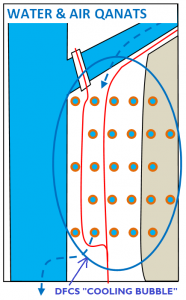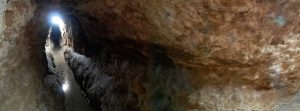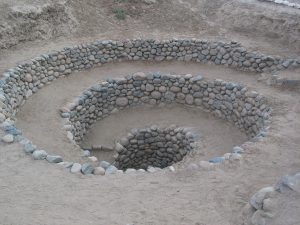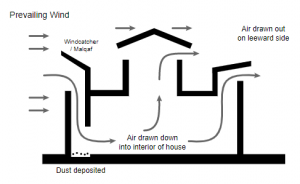Category Archives: Rethinking Energy & Resources
Qanats & Windcatchers for Lytton BC
 The Village of Lytton, BC had a catastrophic fire in 2021, after a wildfire started in the early evening of June 30, 2021, after suffering the highest temperature ever recorded in Canada. After percolating ideas in the back of my head for a year, last weekend, I wrote up a suggestion and sent it to the Village of Lytton and Lytton First Nation; and then afterwards to leaders in the insurance sector (Insurance Institute of Canada, CISO, Institute of Catastrophic Loss Reduction). The suggestion is to propose a way to mitigate future risk in Lytton and similarly situated communities. The concept is to use natural resources to help retard future fires. The idea is to consider the opportunities that arise when the rivers and architecture of the landscape is seen as a fire defence resource. This is an example of my practice to periodically intellectually refresh…by taking a day, here-and-there, to do something else entirely different. Exercise for the imaginative mind.
The Village of Lytton, BC had a catastrophic fire in 2021, after a wildfire started in the early evening of June 30, 2021, after suffering the highest temperature ever recorded in Canada. After percolating ideas in the back of my head for a year, last weekend, I wrote up a suggestion and sent it to the Village of Lytton and Lytton First Nation; and then afterwards to leaders in the insurance sector (Insurance Institute of Canada, CISO, Institute of Catastrophic Loss Reduction). The suggestion is to propose a way to mitigate future risk in Lytton and similarly situated communities. The concept is to use natural resources to help retard future fires. The idea is to consider the opportunities that arise when the rivers and architecture of the landscape is seen as a fire defence resource. This is an example of my practice to periodically intellectually refresh…by taking a day, here-and-there, to do something else entirely different. Exercise for the imaginative mind.A) (See PDF)
B) Civil Engineering Idea
- Water sources (currently the Thompson R. and Fraser R. (in future, perhaps aquifers and springs?)
- Moisture-Sourcing subsurface “Qanats” [underground aqueducts, known as Qanats in the Middle East and as “Puquios” in the coastal deserts of southern Peru and northern Chile);
- Natural wind and heat-activated Air-Cooling “Windcatchers”):
C) Fire Protection Infrastructure Idea
 Create a civil infrastructure administration mechanism called the “District Fire Cooling System (DFCS)” to emulate the familiar “District Energy System (DES)”: https://toolkit.bc.ca/tool/district-energy-systems-2/ The concept here is to use natural resources to create a sustainable DFCS fire retarding system for the village.
Create a civil infrastructure administration mechanism called the “District Fire Cooling System (DFCS)” to emulate the familiar “District Energy System (DES)”: https://toolkit.bc.ca/tool/district-energy-systems-2/ The concept here is to use natural resources to create a sustainable DFCS fire retarding system for the village.Notes:
- Inside Qanat: Naeinsun, CC BY-SA 3.0 <https://creativecommons.org/licenses/by-sa/3.0>, via Wikimedia Commons: https://commons.wikimedia.org/wiki/File:Insideqanat.JPG
- Puquios in Peru: Ab5602, Public domain, via Wikimedia Commons: https://commons.wikimedia.org/wiki/File:Puquios_aqueduct_Nazca_Peru.JPG
- Windcatcher Diagram: Fred the Oyster, CC BY-SA 4.0 <https://creativecommons.org/licenses/by-sa/4.0>, via Wikimedia Commons: https://commons.wikimedia.org/wiki/File:Malqaf.svg
Might Friston’s “Free Energy” Markov Blankets = Liquid Membraning?
 Karl Friston is looking to move forward describing the ‘free energy principle’, for example using the Friston/Ramstead/Babcock paper describing “all life in terms of Markov Blankets.” https://www.wired.com/story/karl-friston-free-energy-principle-artificial-intelligence/ and https://www.sciencedirect.com/science/article/pii/S1571064517301409
Karl Friston is looking to move forward describing the ‘free energy principle’, for example using the Friston/Ramstead/Babcock paper describing “all life in terms of Markov Blankets.” https://www.wired.com/story/karl-friston-free-energy-principle-artificial-intelligence/ and https://www.sciencedirect.com/science/article/pii/S1571064517301409
Another term for Markov Blankets might be “Liquid Membraning”. I use Liquid Membraning in problem-solving; the cognitive process appears to be akin to stitching up data-points into Markov Blankets. “Cloud-Boxing” is my other term. The suggestion here is to shift away from the rigid/fixed/ossifying nature of the term “blankets” to a flow-state framework that evokes particulates and osmoticity? Could the term instead be Markov “fluidics,” “flow-states”, “nets”, “clouds”, and/or “meshes”?
“Liquid Membraning”* is the deep enveloping that evanescently correlates datasets during the gloaming phase of a sort; stitching up cloud-points out of constellations of clues; out of a search to find the deep root cause of a challenge/problem/issue/threat [ie. to go back to the deep root first principle]. This produces a key that when turned unlocks the entire problem. Computationally you could call it super-swarming. It has been suggested that creatives approach a task ‘more intuitively’, not analytically. I disagree; these skills could be characterized as hyperfast analytical tasking. Think of super-swarming as standing in a cloud. Where the cloud is a set of data points. Among these are the discrete clues that I notice. Among these are the patterns and there a route of questions to find, to follow, down to the root clue/key that unlocks everything. Another way to look at this is to say I see all the trees in the forest, and then notice the clue paths and patterns that lead me back to the one different tree.
* definition circa 25 Nov 2018
Image: “Internet map 1024” (cropped), By The Opte Project [CC BY 2.5], https://commons.wikimedia.org/wiki/File:Internet_map_1024.jpg




